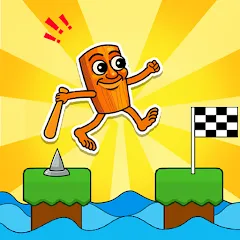
Brainrot Tip Tap Challenge
casino

| App Name | Brainrot Tip Tap Challenge |
|---|---|
| Latest Version | 2.5 |
| Last Updated | 12 Mai 2025 |
| Publisher | TSACom |
| Requirements | Android Android 7.0+ |
| Category | casino |
| Size | 125.60M |
| Google Playstore |

|
In the ever-evolving world of mobile gaming, where trends come and go with the swipe of a screen, Brainrot Tip Tap Challenge has emerged as a fresh, electrifying addition that captures the attention of both casual players and hardcore reflex junkies. This game doesn’t rely on flashy graphics or overcomplicated plots — instead, it brings the essence of gaming back to the basics: timing, precision, and pure reflex. Players are drawn in with a seemingly simple premise: tap at the right time to avoid chaos and survive the madness. But don’t let the simplicity fool you — Brainrot Tip Tap Challenge quickly ramps up the intensity, delivering a gameplay experience that’s as maddening as it is addictive.
What makes this game a standout isn’t just the gameplay loop — it’s the psychological tension it creates. The title “Brainrot” isn’t a random choice. After just a few levels, players begin to feel their minds bending under the pressure, caught in a loop of rapid decisions, missed taps, and near-successes. The colors flash, the rhythm intensifies, and your brain is tricked into a state of hyper-focus that borders on obsession. It’s this mental rollercoaster that makes the game incredibly satisfying for those who thrive on challenge. Every tap counts, and every second of hesitation can end your streak.
For gamers who crave adrenaline-pumping action, Brainrot Tip Tap Challenge is the perfect storm. The game doesn’t hold your hand. There are no “easy modes” or forgiving checkpoints. You either keep up, or you crash. This straightforward design encourages players to get better with each round, pushing their limits and developing muscle memory through sheer repetition. It’s an old-school mindset wrapped in a modern mobile package, and it’s striking a chord with players across the globe.
At its core, Brainrot Tip Tap Challenge thrives on minimalist controls and maximum mental strain. The central mechanic is tapping in response to visual or audio cues — it sounds easy on paper, but the way the game increases speed and complexity is what makes it brutal. The pattern recognition your brain relies on starts to blur, and the game becomes less about reaction time and more about developing a sixth sense for survival. It’s this transformation that keeps players hooked for hours, seeking that perfect rhythm.
One of the key psychological tricks used in the game is unpredictability. Just when players feel they’ve mastered a certain pattern or speed, Brainrot throws a curveball — a sudden shift in tempo, a screen shake, a color inversion. These micro disruptions create a sense of panic, which makes staying focused even harder. The developers have done a brilliant job using simple audiovisual cues to evoke stress, excitement, and even paranoia. This design not only adds depth but also makes every run feel unique, like you’re in a constant battle against your own instincts.
More importantly, the game doesn’t just test your fingers — it tests your brain’s endurance. The feeling of slight mental burnout after a 20-minute session is real and intended. It’s not about relaxing or zoning out; it’s about pushing your cognition to a state of high alert. This is where the true brilliance lies — in turning a simple mechanic into a mental sport. Just like how Tetris was once studied for its effects on the brain, Brainrot Tip Tap Challenge could easily become a subject of psychological fascination for how it forces adaptation under pressure.
Unlike many modern games that rely on hyper-realistic graphics or overly polished visuals, Brainrot Tip Tap Challenge adopts a bold, almost chaotic aesthetic that serves a functional purpose. The neon colors, erratic animations, and pulsing lights are not just there for show — they are integral to the gameplay experience. These visuals are designed to disorient, to push your focus to its limits. The background might flicker, the screen might rotate, or the entire palette might invert mid-game. It’s like being dropped inside a digital rave, where every color is a warning sign and every animation is a distraction.
Despite this visual intensity, the game’s interface remains remarkably clean. There’s no clutter, no unnecessary UI elements. This minimalism allows players to focus solely on the tapping rhythm without being bogged down by menus or side quests. The chaos is controlled — a deliberate contrast between simplicity and stimulation. This makes the game accessible to new players while still appealing to those who enjoy a high-sensory challenge. In many ways, it’s visual poetry in motion, with every flicker and flash telling its own story.
What truly sets Brainrot apart visually is its ability to balance overstimulation and clarity. The game walks a fine line — it wants to overwhelm, but not confuse. It wants you to feel the burn of mental exhaustion without ever questioning what you’re supposed to do. That design mastery elevates the game from being “just another reflex game” to something far more immersive. Whether you play in short bursts or long sessions, the visuals ensure that every moment feels like a spectacle.
The most successful mobile games today share a common trait — they tap into basic human psychology to create a loop of reward and desire. Brainrot Tip Tap Challenge is no exception. Every successful tap releases a small dopamine hit, reinforcing your behavior and urging you to keep going. This mechanism has been studied in everything from casino games to social media apps, and Brainrot uses it masterfully. You start chasing the rhythm, not just for fun, but because your brain has been wired to feel rewarded when you hit it just right.
What adds to the addiction is the game’s brutally honest feedback system. You’re either in the groove or you’re out — there’s no middle ground. This black-and-white outcome pushes players to master the timing, the rhythm, and the sequence. Failing feels harsh, but success feels euphoric. And because the game doesn’t offer many lifelines, every win feels earned. The stakes are high, and that’s exactly what makes each playthrough so exhilarating.
Let’s not forget the social element. While the game is designed as a single-player experience, it thrives in community spaces where players share scores, techniques, and even memes. Here’s the one time we’ll use bullet points to highlight its impact:
Players often share high scores on social media platforms, sparking friendly competition.
Gaming forums discuss strategies to master the unpredictable patterns.
Streamers and content creators take on challenges to see who can last the longest.
This organic community growth boosts the game’s popularity and makes it part of a broader culture — not just a solo experience, but a shared obsession.
Brainrot Tip Tap Challenge is not just a game — it’s a phenomenon in the making. It strips down gaming to its core elements and builds intensity around them. There are no complex narratives or deep upgrade systems. Instead, it’s about raw skill, focus, and mental endurance. This simplicity, paradoxically, is what gives it depth. You’re not just playing a game; you’re training your brain under pressure, pushing your limits in every session. It’s a modern take on arcade culture, and it’s winning hearts across all age groups.
Looking forward, the potential for expansion is massive. Imagine tournaments, global leaderboards, or even VR integration. The gameplay loop is so universally engaging that it could be applied to various formats — from smartwatch taps to motion-based gestures. The developers have a goldmine of opportunity here, and if they continue refining the experience without diluting its core tension, Brainrot could become a staple in mobile eSports and competitive gaming.
So, whether you’re a veteran looking for a new challenge or a newbie curious about what’s trending, Brainrot Tip Tap Challenge deserves your attention. It’s fast, furious, and mentally thrilling. Dive in — and see how long your brain can survive the rot.
You Can Also Download This